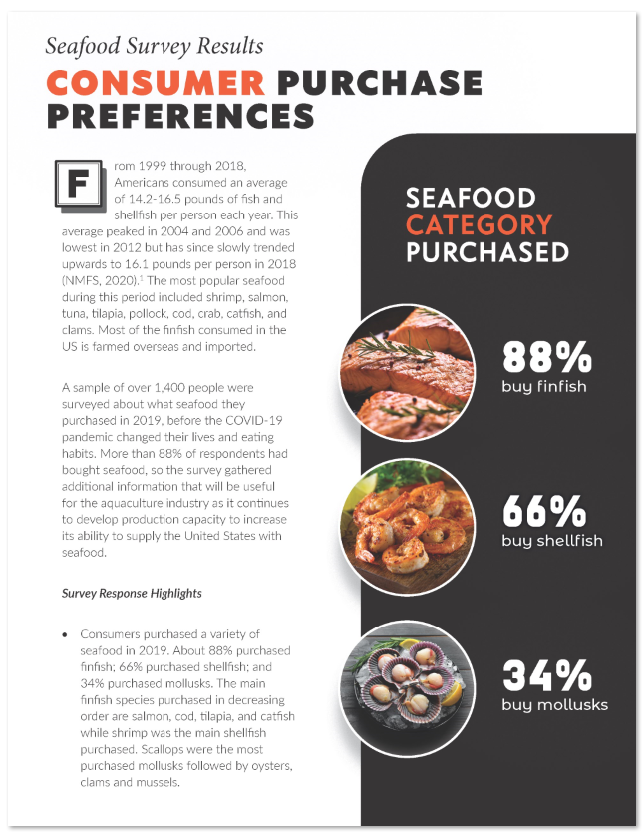Results

File Type: pdf
File Size: 3.87 MB
Year: 2021
This is the fifth in a series of consumer guides that describe fish and shellfish farmed in the Midwest region of the United States. (See Walleye Farmed Fish Fact Sheet, Yellow Perch Farmed Fish Fact Sheet, and Tilapia Farmed Fish Fact Sheet). The fact sheet also includes culinary characteristics, cooking tips, and a recipe for Sautéed Old Bay® Shrimp
References:
- FAO. 2009. Penaeus vannamei. In Cultured aquatic species fact sheets. Text by Briggs, M. Edited and compiled by Valerio Crespi and Michael New. CD-ROM (multilingual). http://www.fao.org/fishery/docs/DOCUMENT/aquaculture/CulturedSpecies/file/en/en_whitelegshrimp.htm.
- Bernal Rodríguez CE, García AC, Ponce-Palafox JT, Spanopoulos-Hernández M, Puga-López D, et al. (2017) The Color of Marine Shrimps and Its Role in the Aquaculture. Int J Aquac Fish Sci 3(3): 062-065. DOI: 10.17352/2455-8400.000030
- National Fisheries Institute (NFI). 2018. “Top 10 List Shows Significant Increase in Seafood
Consumption.” Available online: https://aboutseafood.com/press_release/top-10-list-shows-significant-increase-in-seafood-consumption/
- FAO. 2018. The State of World Fisheries and Aquaculture 2018 – Meeting the sustainable development goals. Rome. License: CC BY-NC-SA 3.0 IGO.
- Ray, A.J. 2019. Indoor Marine Shrimp Farming. SRAC Pub No. 2602. Available online: http://www.ksuaquaculture.org/PDFs/Ray_SRAC%202019-Indoor%20Shrimp%20Farming.pdf
- E R De Oliveira e Silva, C E Seidman, J J Tian, L C Hudgins, F M Sacks, J L Breslow, Effects of shrimp consumption on plasma lipoproteins, The American Journal of Clinical Nutrition, Volume 64, Issue 5, November 1996, Pages 712–717, https://doi.org/10.1093/ajcn/64.5.712.
‡Note: Old Bay Seasoning is a registered trademark of McCormick & Company.
Download File
File Type: pdf
File Size: 2.22 MB
Year: 2021
This document provides results of a 2019 national consumer survey of seafood preferences carried out by Illinois-Indiana Sea Grant, Purdue University, Michigan State University, and Southern Illinois University.
Download File
File Type: pdf
File Size: 1.62 MB
Year: 2021
This is a wallet card-sized brochure that will be distributed to boaters and anglers by Illinois Conservation Police Officers. The brochure contains Illinois’ aquatic invasive species laws and additional recommended actions these audiences can take to prevent the spread of invasive species.
Download File
File Type: pdf
File Size: 2.92 MB
Year: 2021
Lawn to Lake provides information on how to protect water quality through natural lawn care. This rack card explains the benefits of using phosphorus-free (P-free) fertilizer and natural lawn care products.
Download File

File Type: pdf
File Size: 4.10 MB
Year: 2021
This is the fourth in a series of consumer guides that describe fish and shellfish farmed in the Midwest region of the United States. (See Walleye Farmed Fish Fact Sheet, Yellow Perch Farmed Fish Fact Sheet, and Tilapia Farmed Fish Fact Sheet). The fact sheet also includes culinary characteristics, cooking tips, and a recipe for Grilled Rainbow Trout with Apricot Salsa.
References:
- Great Lakes Sea Grant Network. 2019. Salmon and Trout of the Great Lakes: A Visual Identification Guide. IISG19-LWD-BRC-023. https://iiseagrant.org/publications/salmon-and-trout-of-the-great-lakes-a-visual-identification-guide/.
- National Audubon Society. 2002. National Audubon Society Field Guide to Fishes. Chanticleer Press, Inc.
- Stickney, R.R. 1996. Aquaculture in the United States, A Historical Survey. John Wiley & Sons, New York, 372.
- Hardy, R.W. 2002. Nutrient Requirements and Feeding of Finfish for Aquaculture (p. 186). essay, CAB Pub.
- Ladewig, K.F. and Morat, M. 1995. Rainbow Trout. Southern Regional Aquaculture Center Publication No. 224.
- EPA-FDA Advice about Eating Fish and Shellfish. Available online: https://www.epa.gov/fish-tech/epa-fda-advice-about-eating-fish-and-shellfish.
Download File
File Type: pdf
File Size: 325.59 KB
Year: 2021
Energy-intensive development practices contribute to increasing levels of greenhouse gases in the atmosphere, which are leading to shifting climate patterns.
This document is available through the Purdue University Extension Education Store at: https://edustore.purdue.edu/id-524-w.html
Download File
Page 10 of 41
Note: Some older Illinois-Indiana Sea Grant publications have not yet been restructured into ADA compliant formats. We are actively working on this. If you are having difficulty accessing a particular item in one of our databases, please contact iisg@purdue.edu with the name of the item and its URL for further assistance.






